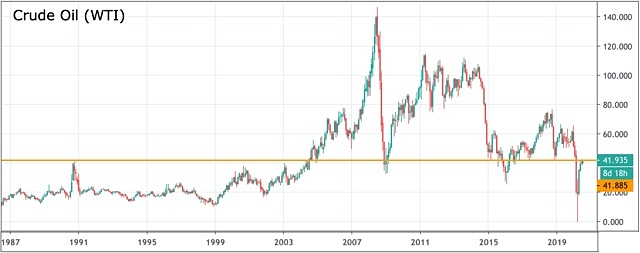Crude oil prices fragile but geopolitical conflict risks could send a shockwave through world economy

Some analysts believe that a geopolitical conflict could spur the oil price to US$80/bbl with multiple regional tensions around the globe. However, increased output could soon flood the market.
The crude oil scene is a puzzle that many people are still trying to work out.
After demand crashed by almost 20 million barrels a day (MMbpd) due to the global pandemic, it was expected that oil prices would keep on tanking.
They did not — so far, or at least not as far as some expected.
But the (still) low prices are causing tensions among producer nations.
Saudi Arabia is already indicating that US$40 per barrel — roughly where oil is now — is not enough for producers there.
Given the fragility of global peace and prosperity at present, there is always the danger of a war or civil unrest that could change the oil balance from over-supply to serious supply dislocations that could reverse prices.
The low prices — overnight US$41.82/bbl for West Texas Intermediate (WTI), US$44.23/bbl for Brent crude — are hurting the producer nations.
Some analysts are even having a bob each way, one suggesting either a downside resistance level for WTI of US$34.78/bbl or, alternatively, a breach of resistance at US$50/bbl.

Historical crude oil price, currently sitting on a key technical line.
China has been stockpiling huge volumes while prices were at rock bottom but now there are warnings that the buying spree may be over.
US producers, especially from shale, are hurting with some filing for bankruptcy — but this week there are reports that the steep fall in US shale oil output appears to be slowing, which is not a good sign given diminished demand in that country.
The COVID-19 pandemic continues to weigh on the global economy — and oil demand — but any confirmation that scientists have found a vaccine could boost both the world economy and oil demand and therefore prices.
Oxford University announced that a potential vaccine may be introduced by September which could have a dramatic impact on the global economy.
A ‘white swan’ event possible
Yet the industry could have what me might call a white swan event — rising conflicts disrupting oil supply from some players but playing into the pockets of all the others.
Egypt’s parliament this week approved deployment of troops to Libya setting Cairo up for a clash with Turkey, but also zapping Libya’s oil output already (in June) down to 93,000bpd.
Reports show Russia is gaining control of Venezuela’s oil industry, and Iran is also involved with Caracas, while the US tries to assert itself there.
Some forecasters believe that US$80/bbl is not out of the question if a major geopolitical conflict (or conflicts) breaks out. We have the China-US standoff, Iran, Venezuela, now Libya, and possibly Nigeria and Saudi Arabia are also in the mix.
The US$80/bbl is frightening in itself: it would send another major shockwave through an already fragile global economy
OPEC+ easing versus second virus wave
OPEC countries are planning to increase production again.
From next month, OPEC+ — the OPEC members plus Azerbaijan, Bahrain, Benin, Kazakhstan, Malaysia, Mexico, Oman, Russia, Sudan and South Sudan — will lift collective production by 1.5MMbpd. Between January 2021 and April 2022, the ceiling on production is planned to lift a further 5.8MMbpd.
Yet last week the WisdomTree WTI Crude Oil exchange traded commodity (ETC) instrument, which allows traders in Europe to invest in commodities without futures contracts or taking possession of the physical commodity, saw big outflows of funds after the OPEC+ announced the easing of previous supply cutbacks.
The Energy Information Administration has since reported that crude inventories were rising globally, while the American Petroleum Institute recorded an inventory build-up of 7.544MMbbl.
The reason: the fear of a second wave of the COVID-19 pandemic, although Saudi Arabia has allowed it may revise output levels if that happens.
One known unknown is China.
Last month it was reported that the world’s second-largest oil consumer had expanded its crude stockpiles to the extent that it had 59 ships lying off the coast, between them holding 73MMbbl of oil.
This oil had been bought in March and April when crude prices collapsed as the virus spread worldwide.
It is the record levels of oil imports by China that has underpinned crude prices and largely prevented further and more damaging falls. Chinese refiners in Shandong province were particularly aggressive buyers.
Now there are reports that, not only is China running out of storage, but the gradually increasing prices may limit further purchases.
US risks output rising too soon
The news has also been looking grim for US producers, especially in the shale sector.
California Resources has filed for bankruptcy owing billions of dollars while Houston-based Bruin E&P Partners, which operates shale oil recovery in North Dakota, has gone down the same path with debt of US$1.1 billion (A$1.53 billion).
Commonwealth Bank commodity analyst Vivek Dhar reported the steep fall in US shale output appears to be slowing — but that carries the risk that US production is coming back earlier than expected, especially with the surge of COVID-19 cases in that country.
The fall in US production had been a good sign for the industry; as Mr Dhar points out, it was a similar fall that triggered a price recovery through 2016.
“We think the responsiveness of US oil supply will dampen any aggressive increase in oil prices and US oil demand,” he said. “There is simply too much spare oil capacity in the US (and elsewhere in the world).”
Until, that is, an unexpected event turns the oil industry on its head.
